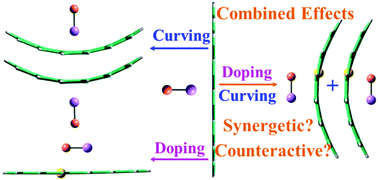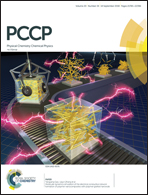Non-covalent interactions for carbonaceous materials: impacts of doping, curving and their combination†
Abstract
Non-covalent interactions play a critical role during the application of carbonaceous materials. DFT calculations are presently employed to study the non-covalent interactions of graphene flakes (GFs) with ion pairs, considering the impacts of doping (electron-deficient and electron-rich) and curving (direction, curvature and surface: inner and outer) as well as their combined effects. The results are relevant to carbon nanotubes, from which curved graphene sheets can be facilely produced. Doping changes the predominant binding configurations and fundamentally affects non-covalent interactions, and all dopants enhance the binding strength, especially the electron-deficient ones that alter frontier orbitals. Curving will not alter the binding configurations but despite the lower impact compared to doping, larger curvatures may result in structural collapse. The changing trends of non-covalent interactions are opposite for inner and outer surfaces. Combined effects during non-covalent interactions are then tackled, producing four influencing factors that decrease as identity of dopant > curvature > curving direction and identity of dopant > surface. The sign of the combined effects (Ω > 0: counteractive while Ω < 0: synergetic) relies strongly on the identity of the dopants, and the other factors contribute less as elaborated in the text. Meanwhile, insightful clues about utilizing different computational methods to handle non-covalent interactions are offered. The results obtained thus far greatly further the understanding of non-covalent interactions regarding carbonaceous materials.



 Please wait while we load your content...
Please wait while we load your content...